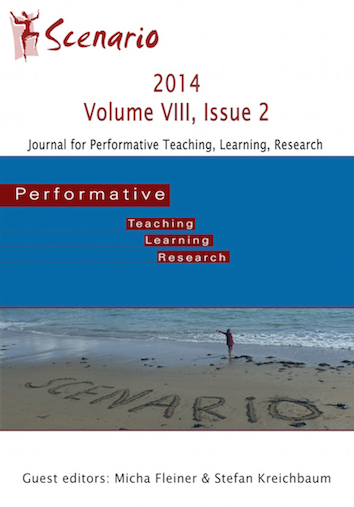Don't Play the Visual, Play the Emotion!
DOI :
https://doi.org/10.33178/scenario.8.2.12Résumé
This contribution aims to introduce SCENARIO readers to my pedagogical practice at the Institute of International Relations, Taras Shevchenko National University of Kiev, which specializes in the training of future Ukrainian diplomats. In order to do so I have opted for the medium of film to give interested colleagues a vivid impression of how I propose to put empathy at the centre of diplomacy-related training programmes. Since prehistoric times empathy has been understood to be a pillar of diplomacy. For Fliess (1942: 212), empathy is the ability "to step into another's shoes", for Etchefoyen (1996: 271) "to feel and understand what another feels", for Stover (2005: 209) "to take the role of the other and to view the world from different perspectives participating in the values, feelings and perceptions of another”. Drama Pedagogy, within the protective space of the imagination, offers many ways of “living through” the lives of others. It therefore seems ideally suited to play a key role in empathy-focused training programmes. Sharing the well-known idea that being in public position is like being on stage but without a script, I developed a teaching concept which blends the diplomatic with the theatrical by using selected film clips in ...Références
Bordwell, David; Thompson, Kristin (2004): Film Art (7th ed). New York: McGraw-Hill
Brest, Martin (1992): Scent of Woman. Universal, DVD
Callas, Maria (1958): Casta Diva. https://www.youtube.com/watch?v=7rjGwS20V94 (Accessed 11 January 2015)
Carnicke, Sharon Marie (2000): Stanislavsky’s System Pathways for the actor. In: Hodge, Alison (ed.): Twentieth Century Actor Training. London: Routledge, 11-36
Eisenstein, Sergey (1949): Film Form. New York: Harcourt Brace and Company
Eisenstein, Sergey (1986): The Film Sense. London: Faber & Faber
Etchefoyen, Horacio (1996): The Fundamentals of Psychoanalytic Technique. London: Karnac Books
Fliess, Robert (1942): The Metapsychology of the Analyst. In: The Psychoanalytic Quaterly 11, 211-227
History Channel: Body Language Analysis of Barack Obama, John McCain and Hilary Clinton. https://www.youtube.com/watch?v=03VUuovloUM (Accessed 11 January 2015)
Isaza, Miguel (2010): How to Train your Dragon. Exclusive Interview with Randy Thom, Jonathan Null and Al Nelson. http://designingsound.org/2010/04/how-to-train-your-dragon-exclusive-interview-with-randy-thom-jonathan-null-and-al-nelson/ (Accessed 11 January 2015)
Leanne, Shel (2009): Say it like Obama. New York: Professional Publishing
Obama, Barack (2004): Keynote address at the 2004 democratic national convention. http://obamaspeeches.com/002-Keynote-Address-at-the-2004-Democratic-National-Convention-Obama-Speech.htm (Accessed 11 January 2015)
Obama, Barack (2006): The Audacity of Hope. Thoughts on Reclaiming the American Dream. New York: Crown Publishing Group
Obama, Barack; Romney, Mitt (2012): The First Presidential Debate. http://www.nytimes.com/interactive/2012/10/04/us/politics/20120804-denver-presidential-debate-obama-romney.html?_r=0#/?annotation=d91950519 (Accessed 8 January 2015)
President Barack Obama's Inaugural Address. http://www.whitehouse.gov/blog/inaugural-address/ (Accessed 11 January 2015)
Pudovkin, Vsevolod (1974): Sobraniye sochinenii [Collected edition], vol. 1. Moscow: Iskusstvo
Schewe, Manfred & Beug, Joachim (1999): Learning and Teaching Culture from an Aesthetic Perspective. In: Intercultural Communication and Language Learning. Dublin: Royal Irish Academy – The Irish Association for Applied Linguistics, 119-134
Stover, William (2005): Teaching and Learning Empathy. An Interactive, online Diplomatic Simulation of Middle East Conflict. In: Journal of Political Science 2, 207-219. http://www.scu.edu/crs/pdf/teaching-learning-empathy.pdf (Accessed 8 January 2015)
Wenner, Jann S. (2010): Obama in Command: The Rolling Stone Interview. In: Rolling Stone, http://www.rollingstone.com/politics/news/obama-in-command-br-the-rolling-stone-interview-20100928 (Accessed 11 January 2015)
Téléchargements
Publiée
Numéro
Rubrique
Licence
(c) Copyright the author(s) 2014

Ce travail est disponible sous licence Creative Commons Attribution - Pas d'Utilisation Commerciale - Pas de Modification 4.0 International.







